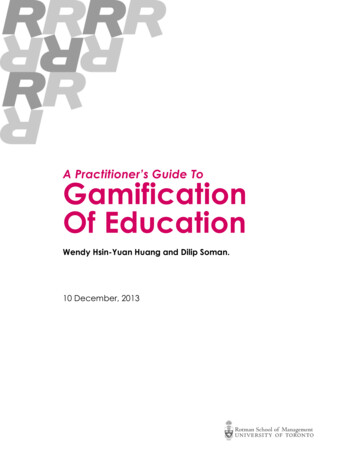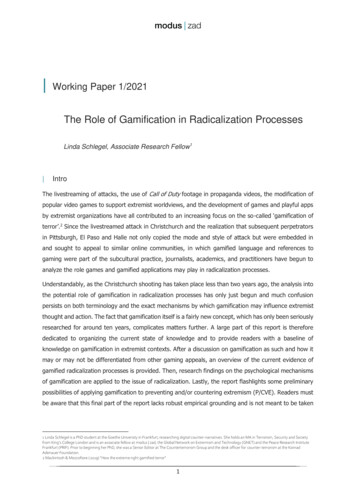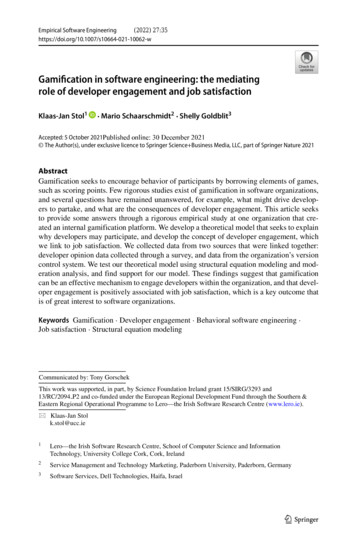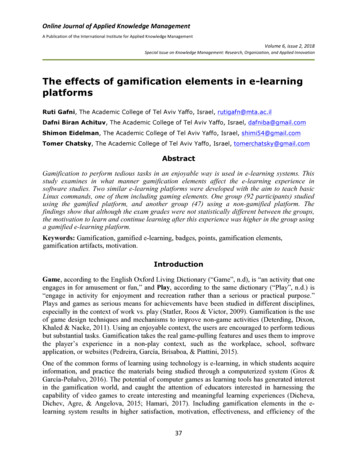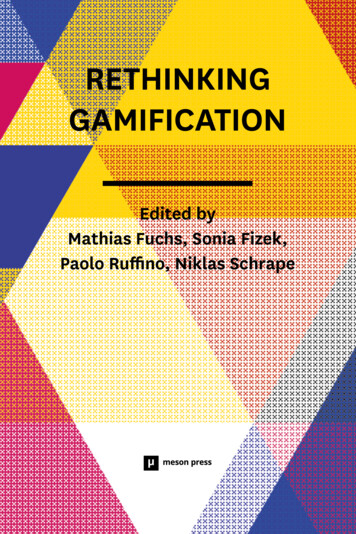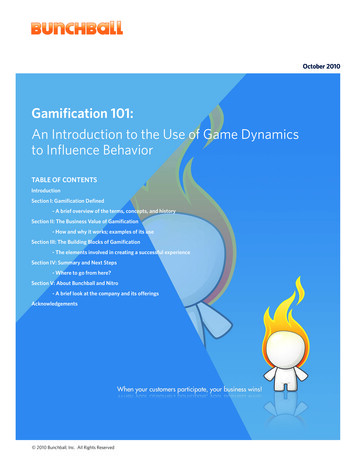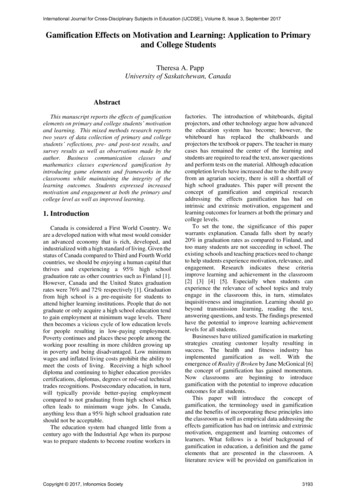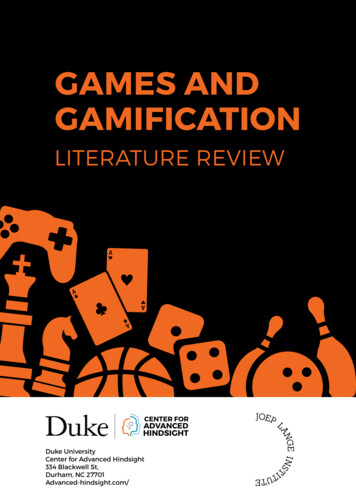
Transcription
GAMES ANDGAMIFICATIONLITERATURE REVIEWCENTER FORADVANCEDHINDSIGHTDuke UniversityCenter for Advanced Hindsight334 Blackwell St,Durham, NC 27701Advanced-hindsight.com/1
This literature review was created by the global team at the Center for AdvancedHindsight:Jan Willem Lindemans (contacting author: jan.lindemans@duke.edu) with NinaBartmann, Judson Bonick, Samantha Garland, Riya Gilja, Will Hopper, Ting Jiang,Rebecca Kelley, Katya Kuzi, Ciara Lutz, Alex Moog, Andrew Schneider and Alec Wall.We acknowledge and appreciate the generous gift from Joep Lange Institute that hasbeen crucial in making this work possible.Interested in collaborating with the Global team, contact: Ting Jiang, Principal, GlobalHealth and Development: t.jiang@duke.edu2
INTRODUCTION: SOME CONCEPTS 3GAMIFICATION OF LEARNING 6EDUCATIONAL GAMES 6GAMIFICATION OF CONTINUOUS LEARNING8WHEN EXACTLY DOES IT WORK?9GAMIFICATION OF OTHER ACTIVITIES13GAMIFICATION OFTEN IMPROVES BEHAVIORS13THE EXTENT OF GAMIFICATION 19LIMITS TO GAMIFICATION 21INDIVIDUAL DIFFERENCES 25EXPERIMENTAL GAMES 28REFLECTION 30REFERENCES 313
INTRODUCTION:SOME CONCEPTSInterventions in health and personal finance increasingly makeuse of games and gamifications. By now there is a substantialliterature on the impact of games and gamification. Beforediscussing that literature, let us take a moment to review what agame is, and what gamification is. This somewhat tedious exerciseis necessary, because gamification is a buzzword used in manydifferent ways, some of which have little to do with games.game/geym/According to the Oxford Dictionary, a game in the broad sense is “an activitythat one engages in for amusement or fun”. In that broad sense, “game” issynonymous with “play”. More specifically, the Oxford Dictionary defines a gameas “a form of competitive activity or sport played according to rules”.In the same spirit, the historical Oxford English Dictionary defines a gameas “an activity or diversion of the nature of or having the form of a contest orcompetition, governed by rules of play, according to which victory or successmay be achieved through skill, strength, or good luck”.From this, we derive a three-part working definition:A game is (1) an activity engaged in for fun (play), (2) governed by rules, (3) in whichplayer(s) try to win. Let’s discuss these three characteristics. 4First, the game is fun to play, and people play it because it’s fun. People desireto win the game, and the excitement caused by the uncertainty of the outcomeis pleasurable. Winning is fun, and losing can be a bit frustrating, but theexcitement about the possibility of losing is part of the fun.- Many games also tap into certain emotions that in real life are negative:feeling nervous, anxious, scared, dizzy, etc. In real life, we don’t like theseemotions. But in games, like in movies, when we know that there is nopossible harm, we can enjoy these emotions. For instance, in real life, thenervousness we feel when seeing a clock tick down towards a deadline canbe extremely unpleasant. In games, it is fun.Second, there is a clear set of rules of the game, and a clear structure. There arerules about what is possible and impossible in the game. Behaviors in the gameoften have clear consequences - clearer than in real life.Third, there are rules about the goal of the game - players can win the game orlose it (binary) in a certain way, or at least perform better or worse (continuous) inthe game. Players may win something tangible, like money or some other prize,or something intangible like a title or honor.
OTHER TYPICAL CHARACTERISTICS OF GAMES. In addition to these three centralingredients, here are some other characteristics that are often present in games. Games are often a simplified simulation of a real event or situation. Many gameshave a story behind them, but games are normally not real themselves. Instead,they have little real-life consequences, and hence they are just play. Games usually have a specific location (e.g., a game board, a field, etc.), and alimited duration of play. Players may compete with other players, or just play “against the game” - on theirown, or collaborating with other players. Many games require some skill, be it physical or mental, and playing the gamemakes you more skilled at it - sometimes causing excellent players to be in a verypleasant state of flow. Many games also have an element of chance, and it is uncertain who is going towin. If it is obvious too soon who will win or lose, the rest of the game is no fun. Many games are made for children, but even the games made for adults oftenstill make use of some imagery that appeals to children (like cartoon figures,fantasy, bright colors, etc.). Many games also make use of humor to make it morefun.A game is an activity that has a substantial number of the above typical characteristics,although it is hard to say which characteristics really need to be present for theactivity to be a game. Note that all these characteristics are possible candidates forexperimentation and manipulation. We will see later that there is surprisingly littleresearch that surgically manipulates individual characteristics in games.gamification/gey-muh-fi-key-shuh n/The Oxford Dictionary defines gamification as “the application of typicalelements of game playing (e.g. point scoring, competition with others, rules ofplay) to other areas of activity, typically as an online marketing technique toencourage engagement with a product or service”.SOFT GAMIFICATION VERSUS HARD GAMIFICATION. Note that this definition doesnot say that gamification is the transformation of an activity into a full-fledgedgame. It says gamification is the application of some game-like characteristicsto an activity, like points or competition. It is making an activity a bit more likea game. And this is indeed how gamification has been most widely conceivedand implemented. We will call the application of some game-like elements toan activity soft gamification. By contrast, we call the transformation of an activityinto a full-fledged game hard gamification. Hard gamification is much rarer thansoft gamification, but it exists. Educational games are a good example of hardgamifications of learning. And perhaps more suprisingly, sports are a great exampleof hard gamifications of exercise. Soccer is gamified running. Hard gamification isvery difficult, because it is difficult to turn a tedious activity into something peoplereally engage in purely because they enjoy it. When friends get together Sunday5
afternoon and the question is raised what game they want to play, no-one will eversuggest to collect points for a rewards programs and to try to achieve Gold status.Rewards programs are soft gamifications, and no-one ever really engages in it purelybecause it is fun. You couldn’t sell it in a game store. But people do play soccerbecause it is fun—not just to exercise. And children do play Little Professor becauseit is fun—at least, some children do. Hard gamification is hard, but its benefits can beimmense. When hard gamification works, more research should be geared towards it.Flatla et al. (2011) provide an instructive process for how to gamify a task. Theprocess involves first identifying the core task or tasks that participants need toaccomplish, and then carefully selecting game elements that can be added.Building on past literature, the researchers identify four basic elements of games.1. The first is that it is challenging: games provide challenging goal elements tied torewards, e.g., collecting items, or shooting objects.2. Secondly, games have a theme: they include vicarious aesthetic representationand unifying aesthetic elements, e.g., cloaking the context or playerrepresentation in a fantasy or with evocative mental imagery, such as alternateworlds or player avatars.3. Third, games provide elements of reward to serve as behavior reinforcement, e.g.,simple visual representations or pleasant sounds, like in the game Candy Crush.4. Lastly, games show us when we have made progress through specific units andmarkers, e.g., levels, worlds, quests, and achievement markers, such as badgesand score information.In what follows, we first discuss the gamification of learning, followed by adiscussion of gamification of other activities, like exercise, saving, etc.6
GAMIFICATIONOF LEARNINGEDUCATIONAL GAMESGames have been widely used to teach knowledge and/or skills that will be usefulin the real world, after the game is played. Such games are commonly callededucational games. We distinguish between one-time educational games (thissection) and other types of gamification of continuous learning (next section).GAMES CAN IMPROVE KNOWLEDGE ANDBEHAVIORS. Educational games can havean impact on health-related behaviors. Forinstance, computer games can be an effectiveway to teach valuable safety tips to disabledchildren. Coles, Strickland, Padgett, andBellmoff (2007) presented 32 children aged4-10 who had been diagnosed with fetal alcoholsyndrome (FAS) or partial FAS with a game toResearch showsteach them either fire or street safety skills. Thethat educationalgame took place in a virtual world in which ananimated dog demonstrated the correct actionsgames can increasein the relevant settings (crossing the street, orknowledge andescaping a house fire). Children then had theimprove behaviors,chance to navigate through these situationscompared toon their own, and the dog positively reinforcedthe children’s behavior when they chose themore traditionalcorrect action, or told them to try again if theyeducation.chose incorrectly. Children were first pre-testedon their knowledge of fire and street safety andpost-tested both immediately after they hadachieved “mastery,” (i.e., were able to navigatethrough the correct actions in the game without the help of the avatar) and oneweek later. The children were also asked to demonstrate the correct sequence ofboth behaviors in real life.Immediately after playing the street safety game, those who had played thefire safety game demonstrated significantly increased knowledge of fire safety,and those who had played the street safety game demonstrated significantlyincreased knowledge of street safety. Knowledge of fire safety one week later wasstill significantly higher compared to fire safety knowledge in the initial pretest,but knowledge of street safety was only marginally improved. This knowledgealso translated into actual performance, as the vast majority of children correctlyperformed 3-4 out of 4 of the desired behaviors related to fire safety bothimmediately following game mastery (87.5%) and one week later (81.3%). Mostchildren also correctly performed 3-4 of the desired behaviors related to street7
safety immediately following the game (81.3%) and one week later (75.4%). Thisgamified intervention thus had somewhat lasting effects.Games have also improved language learning. Calvo-Ferrer (2017) examined theeffect of using computer games as stand-alone learning tools on learning gainsand found that game increased vocabulary acquisition significantly more thana stand-alone booklet containing the same information. Fifty-nine English as aSecond Language students of Spanish nationality (ages 19-20) participated inthe study. These students were divided into two groups - one group who playedan educational game called The Conference Interpreter, and one group whichreceived a booklet with the same information contained in the game, but withoutthe rewards (such as digital ribbons and level-ups), score tables, and power-upsof the game. The experiment was carried out over five days. On the first day, thestudents were given pre-test questionnaires and assessments, as well as assignedto the different treatment groups. In the next three days, the students individuallyused either the computer game or booklet in 2-hour sessions. On the fifth day, thestudents were given post-test questionnaires and assessments.An analysis on the assessment scores of the students post-intervention found thatstudents who utilized the computer game scored significantly higher (M 35.56 outof 63) than those given the booklet (M 31.63 out of 63). The author concluded thatThe Conference Interpreter game helped students gain vocabulary more effectivelythan information alone, and that this type of intervention could be a powerful toolsince it does not require any instructional support.Figure 1. The Conference Interpreter8
GAMES CAN REDUCE COGNITIVE BIASES. Morewedge et al. (2015) shows that itis possible to create computer games of debiasing training to reduce cognitivebiases. In both experiments, participants were either assigned to watch a 30-minuteinstructional video, or to play a 30-minute debiasing video game. The instructionalvideo defined heuristics, described what each bias was, and showed vignettesof actors demonstrating each bias, while the video game task was to simply finda missing neighbor. Within the video game, participants were presented withsituations in which they might commit each cognitive bias. At the end of eachlevel, the game described each bias in detail and had participants rate how biasedthey were during the game. Participants were immediately given feedback abouttheir level of bias. In experiment 1, the researchers sought to decrease the effectsof a) bias blind spot, b) confirmation bias, and c) fundamental attribution error.In experiment 2, the researchers were trying to decrease the effects of anchoring,projection, and representativeness heuristics.In both experiments, the authors found reductions in cognitive biases that arecritical to intelligence analysis. Both produced medium to large debiasing effectsimmediately (31.94% reduction in the video game condition; 18.60% reductionin the instructional game condition) that persisted even 2 months later (23.57%reduction vs. 19.20% reduction).GAMIFICATION OF CONTINUOUS LEARNINGGAMIFICATION OF LEARNING. As with one-time educational games, the gamificationof continuous learning may effectively increase learning. Nevin et al. (2014) conducteda study on gamification-based software for learning medical information on medicalresidents that showed high levels of acceptance, use of software, and retention ofknowledge. Note that this study did not have a control with non-gamified learning, sowe cannot conclude that the gamification is what worked.Students used the software to complete questions individually, and in a group, viaanonymous usernames. Three rounds of questions on a variety of topics were pickedby the faculty. Round 1 was open to 128 students at the University of AlabamaBirmingham only. For round 2, 24 University of Alabama Huntsville residents werealso invited, and round 3 was open to all students. Round 3 consisted of 3 dailyquestions – 2 new ones and one repeat from round 1 or 2. Points were given forcorrect answers, continued daily participation and streaks of correct answers. Theleaderboard was updated continuously, and participants could see the scores ofother participants whose scores were just above and below their own.Focus groups conducted after round 1 determined that the leaderboard was themost important motivator, with people or teams at the bottom of the leaderboardexperiencing less motivation as the competition progressed. The number ofparticipants decreased after each round, yet there was a statistically significantincrease in use of the program after weekly competition status emails were sent.28.8% of questions were answered on weekends between 17:00 and 08:00 (outsidenormal teaching hours). Players were correct 11.9% more frequently when aquestion was repeated.The limitations were that internal medicine was the only speciality tested and onlyresidents who volunteered to participate were included.9
WHEN EXACTLY DOES IT WORK?LEARNING INTRINSIC TO THE GAME. Making educational elements intrinsic to aneducational game improves learning. Habgood and Ainsworth (2011) found thatchildren improved their mathematical abilities more when given an educationalgame when the math education in the game was intrinsic to the game itself. Theauthors define intrinsically integrated games as (a) delivering learning materialthrough the parts of the game that are most fun to play, riding on the back ofthe flow experience produced by the game, and not interrupting or diminishingits impact, and (b) embedding the learning material within the structure ofthe gaming world and the player’s interactions with it, providing an externalrepresentation of the learning content that is explored through the core mechanicsof the gameplay.The authors created a video game called “Zombie Division” specifically for thisstudy. This game involves a fantasy context where the main character battlesskeletons with symbols on their torso, where the symbols indicated what kinds ofattacks would be effective in slaying them. There are three versions of this game,representing the three conditions of the study. First was the intrinsic condition,where the symbols on the skeletons were numbers and the attacks to slay themhad corresponding number values. A skeleton could only be slain by an attack thatcould divide into the number on their torso (a #9 skeleton could only be slain bya #3 attack). The skeletons in the extrinsic and control conditions had symbols ontheir chest corresponding to the attacks that would slay them, but the attacks werenon-numeric such as a sword or shield, thereby having the same exact gameplayin all conditions but hiding the mathematical aspects in the extrinsic and controlconditions. In the extrinsic condition, the mathematical content was delivered ina quiz at the end of each level of the game. In the control condition, there was nomathematical content in the game at all. All 58 of the children in the study alsoreceived a teacher-led reflection session about mathematics after the children hadbecome familiar with the game, but had not spent a large amount of time with it.Participants completed the mathematics outcome test as a pretest 10 days beforethe study started, as a post-test after the children had spent 100 minutes with thegame, and as a delayed test given after the children’s final playing session.Figure 2. (from Habgood & Ainsworth, 2011): “Explanations of mathematical learningcontent in the intrinsic (left) and extrinsic (right) versions of Zombie Division.Comparable features are labeled”10
Children who played the intrinsic version of the game not only maintained theirmathematical abilities, but improved further on the following delayed test (50% to60%). The extrinsic and control children, on the other hand, only maintained theirprevious levels of mathematical skill (at 39%, and 36% respectively).Figure 3. (from Habgood & Ainsworth, 2011): “Mean Percentage Score by Time andGame Condition”GAMES NEED TO BE ALIGNED WITH LEARNING GOALS. de-Marcos et al. (2016)compared several game-like approaches to learning: full educational games,gamification only, social networking only, and social gamification. They found thatwhile all approaches significantly impacted learning, social gamification was themost effective. However, depending on the type or the time of the assessment,some of the approaches performed significantly worse than the control group.The authors recruited 379 undergraduate students attending a course on basiccomputer literacy (the MS Office applications Word, Excel, Powerpoint and Access),who were divided into five conditions, which were given the following treatments: a)the control condition, in which participants received standard blended learning, b)the educational game condition, in which participants played the Microsoft gameRibbonhero (this ready-made game not directly aligned with the course’s learningobjectives, teaches Office functions by helping an avatar to solve challenges), c)the gamification condition, in which learning objectives on the online learningplatform were described as challenges, trophies were awarded, and a leaderboardkept track of people’s performance, d) the social condition, in which students couldcommunicate on a social network by posting blogs, answering Q&A’s, or postinglinks to resources as well as liking and friending each other, or e) the gamified socialcondition. The gamified social condition was the same as the social condition,but with gamification rewards for social interactions, such as points for answeringquestions or participating in peer grading, and a leaderboard; points could also beused to buy items such as 5% on the final mark or avatar improvements.11
In all conditions, including the control, participants had one lecture every two weeksand had to study independently in between. There was a pre-test before treatmentsbegan, an assignment at the end of every two-week module testing practicalknowledge of the module, and one final assignment at the end of the course testingconceptual knowledge of all four modules.In the practical assignments, all treatment conditions outperformed the controlgroup. In the final conceptual exam, however, only the gamified social treatmentgroup achieves results similar to the control group, with all other groups performingworse (mean grades: control 74.77, educational game 66.30, gamification 59.50,social 61.24, social gamification 72.00). The researchers hypothesize that this maybe due to “shallow gamification,” particularly for a learning game that is not alignedwith learning objectives, and to gamification leading to an increase in the numberof interactions with the learning material, but not in their quality. Unfortunately,their research design does not allow a conclusion on whether the type or the timeof assessment are responsible for the worse performance of most approaches onthe final exam.For practical gamification applications, this should serve as a warning not to havethe gamification elements overshadow the actual learning content—in other words,they should motivate students to engage with the learning content, rather thandistract them from it.DOES GAMIFICATION WORK BETTER FOR PRACTICAL SKILLS THAN FORTHEORETICAL KNOWLEDGE? Dominguez et al. (2013) show that students withthe opportunity to complete a gamified online university course performedbetter on practical tasks compared to students who completed a non-gamifiedversion, although there was no difference in final grades. The results also show thatgamification has the potential to increase student motivation.The researchers studied student motivation toward completing optional exercisesusing the online course “Qualification for users of ICT”, which was a 15-weekcourse in the 2011/2012 spring semester that teaches various Information andCommunications Technology (ICT) tools. Students could sign up for the same courseon either of two campuses. One group of 80 students was randomly assigned tocomplete the regular, non-gamified online course, which offers downloadableoptional exercises to prepare for the final exam, whereas the other group of 131students completed the gamified course, in which the optional exercises to preparefor the final exam were available online in a gamified version. The video-game-likeexercises had three unique design features. First, students could complete twochallenges per topic, and within each challenge, they could complete four tasksthat were each rewarded with a trophy (copper, silver, gold and platinum). Second,by successfully completing tasks, students were awarded medals. Students knewthat some medals would be awarded upon completion of a known task, whereassome medals were awarded by surprise when a special task was completed. Third,the authors included an element of competition by introducing a leaderboardthat ranks players according to their number of medals earned. Students in thetreatment group, however, were free to choose whether to use the gamified version,the paper version or a combined version for their optional exercises. Fifty-eightstudents decided to use the gamified version of the course.12
Looking at the four core modules of the course, students in the treatment groupperformed better in practical exercises about spreadsheets (11.24 points more ona 100 point scale), software presentation (25.27 points more) and databases (29.4points more). However, there was no difference in students’ performance on wordprocessing and in students’ final grade for the course.13
GAMIFICATION OFOTHER ACTIVITIESGAMIFICATION OFTEN IMPROVESBEHAVIORSStudies have shownthat gamifyingunpleasant activities,like exercising andsaving, can makepeople participate inthese activities more.GAMIFICATION OF WALKING (STEPS GOALS). In anintervention aimed at increasing physical activity, Patelet al. (2017) found that participants in the gamifiedstudy arm achieved their step goals for a significantlygreater proportion of days as compared to the nongamified control arm. This was also true in the monthsafter the intervention. All 200 participants had at leastone family member participating with them in thestudy and used either a smartphone app or a wearabledevice (e.g., Fitbit) to track step counts. During a twoweek run-up period, participants established a baselinestep count and then chose a step goal increase of 33%,40%, 50% or any goal of at least 1,000 steps greaterthan baseline. All participants received daily feedbackvia text and/or email that informed them whether theyhad achieved their step goal on the previous day.Participants in the gamified study arm signed an online pledge committing totry their best to achieve their daily step goal and were also entered into a 12-weekgamified intervention with their family. Each Monday, the family received 70 points(10 points for each day of the week) and each day of the week a family member wasselected at random to represent the family’s step count. If that member achievedhis/her step goal, the family kept its 10 points. If not, the family lost 10 points for thatday. All families started out at a bronze level and had the opportunity to advanceup a level each week (bronze, silver, gold, and platinum). They advanced up a level ifthey maintained 50 points or more by the end of the week. If the family was at thegold or platinum level by the end of the intervention period, they received a coffeemug branded with the study logo. Lastly, all family members had five lifelines thatthey could use on days when it was not feasible to achieve their steps goal.The mean proportion of days that participants in the gamified study arm achievedtheir steps goal during the 12-week intervention period was 0.53 as compared to0.32 in the control arm. During the 12-week follow-up period where steps werecounted after the end of the intervention, this trend continued. During the follow-up period, the mean proportion of days that participants in the gamified studyarm achieved their steps goal was 0.44 as compared to 0.33 in the control arm.These results indicate that gamified elements have the potential to not only increase physical activity in the short-term but can also create sustainable habits ofincreased physical activity.14
GAMIFICATION OF OTHER HEALTH BEHAVIORS. Adding a gamification elementto blood glucose monitoring has also helped diabetic children keep their bloodglucose levels down. Kumar, Wentzel, Mikkelsen, Pentland, and Laffel (2004)conducted a 4-week randomized clinical trial with 40 children aged 8-18 with type1 diabetes (one participant had type 2) who were regularly treated with insulinand already regularly monitoring blood glucose levels. Each participant received aPDA, as well as diabetes software and equipment. Participants were encouraged tocheck their blood glucose at least 4 times a day, and to upload their blood glucose,carbohydrate intake, and insulin dose data into the PDA. This data could be sentwirelessly to the researchers. Half (19) of the children were also given a game inwhich they could see the first 3 blood glucose levels they recorded that day, andwere instructed to guess what the 4th reading would be. They were awarded pointsfor simply playing the game, and even more points if their blood glucose predictionwas accurate. There was no element of competition, as the participants played thegame against themselves.The treatment group sent in their data significantly more often (1,662 values) compared to the control group (1,471 values, p .001). During the experiment, the treatment group also experienced high blood sugar significantly less often (318 times)than the control group (377 times, p .001). The children in the treatment group alsoexhibited greater knowledge of diabetes at the conclusion of the experiment compared to the beginning (p .005). This difference was marginally significant in thecontrol group (p .09), but the researchers did not directly compare the two groups’diabetes knowledge.GAMIFICATION OF PERSONAL FINANCE. In this paper, Liu et al. (2017) describe thedesign process and prototype for a savings app that involves gamification as wellas other behavioral interventions. After review, an unstated claim from Liu et al.(2017) seems to be that to maximize success of the product, multiple interventionsneed to be leveraged. The product leveraged interventions across the target userjourney of planning, saving, and keeping. Both of the gamified features in the appwere found in the savings section: (a) Personal savings challenges gamification: afeature allowing the user to set personal saving challenges against him/herself (ora computer). Based on data analytics, the app automatically suggested potentialchallenges and amounts to the users and sent prompts on their progress, and(b)Social Influence gamification: a platform to compete with peers or familymembers on the pre-selected savings challenges (like a FitBit for savings).The team tested the prototype through 50 behavioral interviews in the field, but thepaper includ
SOFT GAMIFICATION VERSUS HARD GAMIFICATION. Note that this definition does not say that gamification is the transformation of an activity into a full-fledged game. It says gamification is the application of some game-like characteristics to an activity, like points or comp

